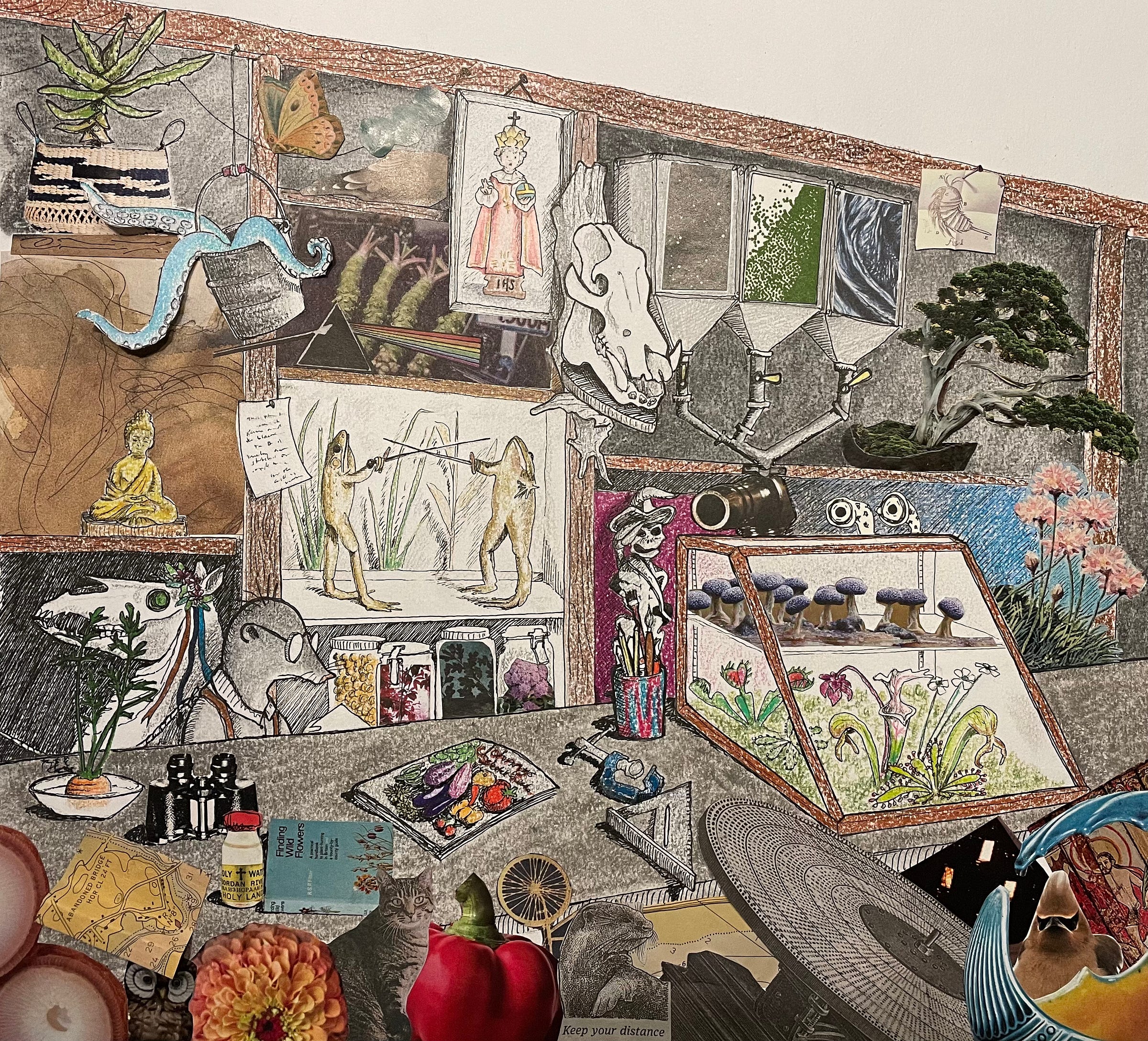This post is second in a series based on a prompt from my therapist: riffing on the Internal Family Systems theoretical framework, she invited me to name and describe the different entities that make up my self, and my mind. First was Wim. Second, the proprietor.
I am trying out the audio narration option for the first time here, so if you prefer to listen to the story, by all means, press play, and let me know what you think.
Wim got to the shop door to find the closed sign hanging there. Wordless, bearing only a carved image of a long-lashed, shut eye, Wim turned it around to display a wide open one and pushed through the unlocked door. The proprietor was seated, as usual, on a stool behind a long soapstone counter salvaged from a middle school science classroom. As a result of its prior life, scratched into its surface were a lot of rudimentary drawings of penises, and pairs of initials in hearts, and the words “Amanda gave me clamidya.”
“Why do you always leave the closed sign up,” Wim asked, emptying the contents of several pockets onto the counter, “you’re always here.”
“By chance or by appointment,” the proprietor answered.
“But you don’t take appointments and there’s never any chance,” Wim said.
“You turn up with these piles of flotsam and jetsam and detritus so frequently I don’t have time to sort it all. It’s a fire hazard and I’m not taking that on my conscience simply because you’re in a hurry.”
Wim’s hair was a tuft of milkweed silk. “I just think you could let people in more often and not wait until you’ve got things just so all the time. People can appreciate all this now and not wait until you’ve got it all polished to a high sheen.”
The proprietor waved a finger toward the back of the shop. “Air lock, Wim.”
The air lock looked like an old phone booth with rubberized seals at all the joins. Once inside, Wim felt the rush of air as the system revved. A sign indicated that Wim should pick up a hose attachment mounted on the wall and thoroughly vacuum out all pockets, folds of fabric, and turned up hems. Wim did, and, once finished, headed back out of the booth. The proprietor was already scrutinizing the airlock’s printout—a graph with multi-colored peaks of varying heights. Wim didn’t understand how they worked, and was perpetually amazed when the proprietor turned the little graphical mountains into an exact report of where Wim had been.
“Elementary school cafeteria, then the little harbor on a falling tide, a long stint in the bakery, and a sit by a campfire—red oak fueled, wet wood, punky.”
The proprietor was like this; he took complex things apart into their parts, and then combined things in weird ways no one ever heard of before. The system of organization in the shop was discernible to no one else but him. He sifted and sorted whatever Wim brought in. His shop was tidy, but it was always unclear why one thing belonged with another. He’d devised a series of metal hoppers that he sorted things into based on his inscrutable logic. Pipes led from each hopper down to a single spigot. Little knobs and levers controlled the input from each one, so the mixture could be titrated. What came out the spigot was a sort of three-ply yarn that the proprietor could make stories out of. He also had a device that was kind of a reverse prism attached to a sort of juicer. The colors would get squeezed out of whatever things he put into it, and then all those colors would focus together through the prism into a single lightbeam that he could write with. All of this is approximate; no one really knows how the proprietor decides what goes with what, or how exactly he makes the things he makes, but he does decide, and he does make, and when people see the things he connects and juxtaposes they always end up saying, “You’re right, it is like that.”
Wim pointed to the door and said, “If you’re going to keep the closed sign up all the time, why do you leave the door unlocked?”
“Because when the closed sign is up, no one tries the door except you, Wim. You are an agent of chaos.”
The proprietor was wearing a set of suspenders joined at the back in a kind of harness he’d made with a swivel mounted on it between his shoulder blades. Attached to the swivel was a long, silken cord like the one tied to Wim’s overalls. The cord ran up through a series of pulleys to a high corner of the room, and then out the building through a little square window. The cord went taut just now. “Duty calls,” said the proprietor. “I know,” said Wim, and went to turn the sign back to closed.









Share this post